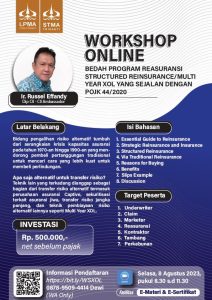LPMA Trisakti – Bedah Program Reasuransi Structured Reinsurance/Multi Year XOL – Selasa, 08 Agustus 2023 | 0830 – 1130 | POJK no. 44/2020

Tautan Pendaftaran:
Q: Definitions of the term ‘structured insurance’ seem to vary – can you define it for us more closely?
Grant Maxwell: Definitions do vary because what we are talking about is Alternative Risk Transfer (ART), and that makes it a very broad space. By terms like structured reinsurance, structured insurance, or reinsurance, what we mean is applying different techniques to help a client achieve exactly what they want from their insurance or reinsurance program. Examples of that could be multi-year and multi-line transactions, which achieve diversifications across time and class. We also use a combination of different limits – per line, per year, or aggregate limits – and the same goes for deductibles.
By optimizing the program, we can minimize cost. We also typically have return premiums and/or additional premiums, so that achieves alignment of interest between the client and the insurer and allows the client to share in the overall performance of the product. We can manage this kind of insurance directly with the corporate, or as reinsurance behind a captive. The principles are basically the same, but it often works well as reinsurance behind a captive because a client who has a captive is probably already thinking about retaining risk and financing that over time. Structured reinsurance is therefore not such a big leap.
Q: What are the other benefits of these programs and structures for corporates?
Q: How popular is structured reinsurance for large companies with complex risk profiles, and where is the trend in this area heading?
Q: The insurance market has been challenging for a few years now. How do pricing fluctuations impact a structured program and have they encouraged risk managers to explore this route?
Grant Maxwell: They are certainly a big driver of growth. The increased prices and reduced capacity in the hard market could push clients towards retaining more risk, but they may end up with more volatility than they are looking for, so structured reinsurance becomes an attractive alternative.
Although this situation could have been a catalyst for increased take-up, I don’t believe it is the only reason. There is an increasing level of sophistication in risk management that is also driving this. We have seen this borne out not just in the last couple of years, but the whole cycle before that. Once a company buys a structured reinsurance program, they tend not to leave it. In fact, it often adds in more lines of business over time. As the market starts to soften, I think interest in structured programs will remain.
Q: What are the challenges that structured programs can present to risk managers?
Grant Maxwell: These are specialized programs, and the risk manager needs to have a very clear view of what they want to achieve. Is their primary concern cost-saving or is it a lack of traditional capacity is available? What is their desired balance between risk retention and risk transfer? And what timescale are they looking at? We find three or five years is a typical time horizon.
We work collaboratively with them to achieve those goals and meet those needs, which takes time. I would say it takes at least three months to put one of these in place. It’s important to establish the client’s motivations early in the process because in certain circumstances there may not be a solution that works, or which is more attractive than what’s available in the traditional market or through self-retention. In addition, the risk manager may then need to bring on board their chief financial officer and other stakeholders to get it over the line internally, which can also take time.
Q: How does AGCS work internally to ensure the smooth implementation of such complex programs?
Grant Maxwell: Creating one of these programs requires the ability to work seamlessly across different lines of business. We need to be able to model the transaction and different structures and scenarios, we need to think about operations needs such as policy issuance, premium payments, and claims, and we need to create bespoke documentation for a structure that is not standard. There are a lot of things that must come together.
Our approach at AGCS is to have a dedicated standalone ART team that works closely with other lines of business but retains its own underwriting authority. We don’t need sign-off from those lines of business, which is significant, because when you’re creating a program of this kind, you need to be able to look across the whole program, not each element on its own. We have the modeling, claims, operational and legal expertise to bring a cross-functional deal team to the task.
Q: When you’re working on structured reinsurance, do you handle fronting as well – or is that a separate issue?
Q: Do you offer 100% standalone fronting and multi-line fronting?
Grant Maxwell: Absolutely. Because we’re not tied to or limited by our own risk transfer appetite, we can make the best use of our broad, cross-line-of-business, and multinational capabilities. We are growing this area of our business.
With multi-line fronting, we typically have a master program that covers multiple lines of business, with perhaps a multi-year relationship. Within that, we will define aggregate limits, service levels, and collateral requirements. Then there are underlying policies in each country and each line of business. Depending on the location, it can sometimes be a multi-line policy in one location, sometimes it’s separate individual policies, but they are all gathered under the master program. What is important to note is that this is flexible, and lines can be added to it over time.
Captives are growing so there is more interest in multi-line fronting. In fact, we’re seeing growing interest in the whole alternative risk transfer space.
LPMA Trisakti – Bedah Asuransi PARAMETRIK | Selasa, 11 Juli 2023 – CEPAGRAM





